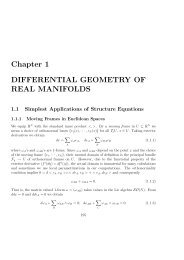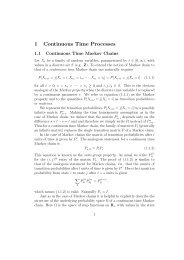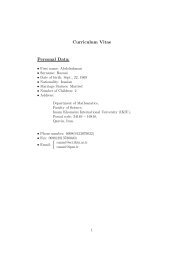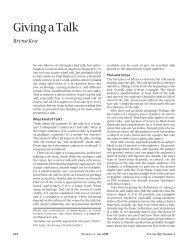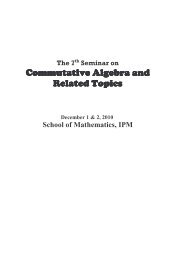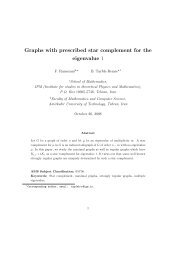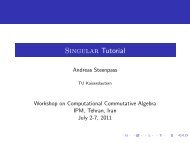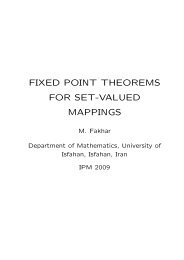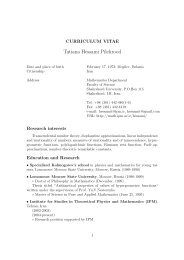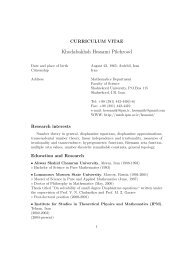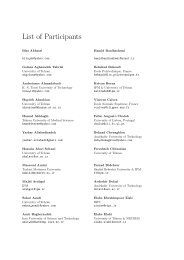Betti numbers of modules over Noetherian rings with ... - IPM
Betti numbers of modules over Noetherian rings with ... - IPM
Betti numbers of modules over Noetherian rings with ... - IPM
You also want an ePaper? Increase the reach of your titles
YUMPU automatically turns print PDFs into web optimized ePapers that Google loves.
Chapter 3: Growth <strong>of</strong> the <strong>Betti</strong> sequence <strong>of</strong> the canonical module 50<br />
Lemma 3.4.1. Let J be an ideal <strong>of</strong> R generated by a regular sequence f1, · · · , fn and<br />
let I be an ideal containing J. Then for j ≥ 0<br />
1. Ext j<br />
R (R/J, R/I) ∼ = (R/I) (nj)<br />
.<br />
2. Tor R j (R/J, R/I) ∼ = (R/I) (nj)<br />
.<br />
3. More generally, Ext j<br />
R (R/J, N) ∼ = N (nj)<br />
R<br />
and Torj (R/J, N) ∼ = N (nj)<br />
for each R-<br />
module N which is killed by J.<br />
Pro<strong>of</strong>. (1) & (2) Since J is generated by a regular sequence we may use the Koszul<br />
complex K•(f1, · · · , fn; R) as a free resolution <strong>of</strong> R/J : if U1, · · · , Un is a basis for the<br />
free module in degree one such that Uj maps to fj, then the elements Ui1∧· · ·∧Uij such<br />
that i1 < · · · < ij are a free basis for the free R-module Kj = Kj(f1, · · · , fn; R). Since<br />
I contains J, when we apply HomR(−, R/I) (resp. − ⊗R R/I) to K•, the maps in the<br />
complex all become 0, and the jth module may be identified <strong>with</strong> HomR(Kj, R/I) ∼ =<br />
HomR(Kj, R/J) ⊗R R/I (resp. Kj ⊗R R/I ∼ = (Kj ⊗R R/J) ⊗R R/I). We may take as<br />
an (R/I)-free basis the image <strong>of</strong> the basis for HomR(Kj, R/I) (resp. (Kj ⊗R R/I)). In<br />
particular, Ext 1 R(R/J, R/I) ∼ = (R/I) n (resp. Tor R 1 (R/J, R/I) ∼ = (R/I) n ). The same<br />
idea works for higher Ext and Tor <strong>modules</strong>.<br />
(3) The idea is essentially the same. Replace R/I by any R-module N which<br />
is killed by J. Then we get Ext j<br />
R (R/J, N) ∼ = N (nj)<br />
∼ j<br />
= ExtR (R/J, R/J) ⊗R N and<br />
Tor R j (R/J, N) ∼ = N (nj)<br />
∼ R<br />
= Torj (R/J, R/J) ⊗R N as well.<br />
The formulation <strong>of</strong> case (‡†) is given in the following:<br />
Theorem 3.4.2. Let R be a local ring and let M be a non zero R-module for which<br />
0 → (R/I) a → M → (R/J) b → 0 is an exact sequence where J is an ideal <strong>of</strong> R<br />
generated by a regular sequence f1, · · · , fn and let I ⊇ J. Let t be an integer.



